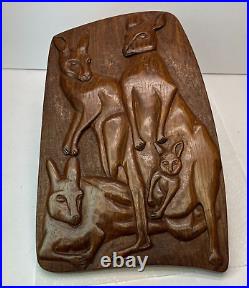
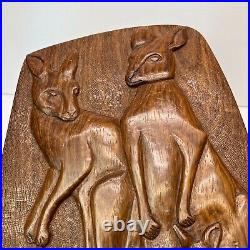
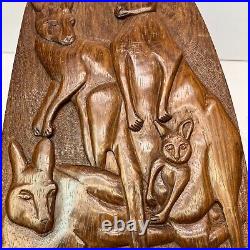
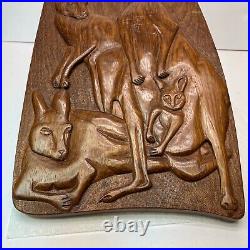
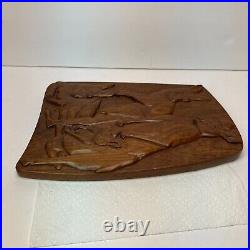
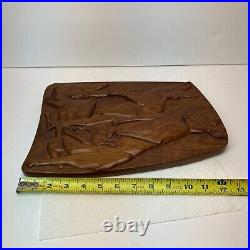
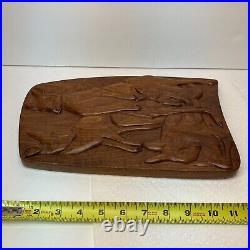
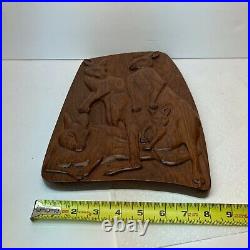
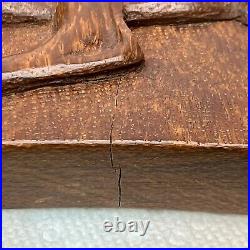
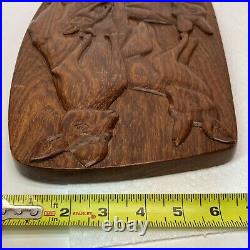
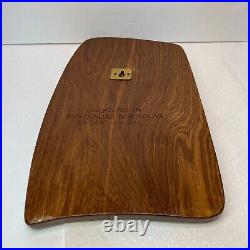
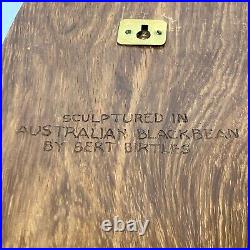

VINTAGE BERT BIRTLES AUSTRALIAN CARVED BLACKBEAN WOOD WALL SCULPTURE KANGAROOS. Dora was born on 2 April 1903 at Wickham, Newcastle, fifth of seven children of English-born Albert Frederick Toll, coal carter, and his New South Wales-born wife Hannah Ellen, née Roberts. Dora grew up in a prosperous and conservative home in which reading was not encouraged. Educated at Wickham Public and Newcastle High schools, she accepted a Teachers College bursary and exhibition to the University of Sydney in 1919. Herbert, known as Bert or Kim, was born on 11 July 1900 at Richmond, Melbourne, fourth of six children of Victorian-born Herbert Birtles and his South Australian wife Elizabeth, née Grenfell. His father was a railway worker from Gippsland, while his mother took in sewing. Bert attended Burnley State School then studied at Zercho’s Business College in Collins Street, Melbourne. He worked as a clerk while developing his journalistic skills by reporting the talks of speakers along the Yarra Bank for. The newspaper of the Socialist Party of Victoria. In 1919 he travelled to Queensland where he attended a Workers’ Educational Association camp at Mount Tamborine, leading to work as secretary to T. Witherby, director of tutorial classes at the University of Queensland. Removing to Sydney, Bert enrolled at the University of Sydney as a non-degree student, taking courses in philosophy and psychology. His leisure time was spent writing poetry and mixing with the atheists, nihilists, and anarchists of Sydney’s Bohemia. He met Dora in 1922. They shared a love of writing and Dora was intrigued by Bert’s left-wing politics. In 1923 both Bert and Dora had poems published in the University of Sydney student magazine. Bert’s erotic poem,’Beauty To D. ,’ drew censure from the university’s proctorial board. The university expelled him for the offence of’misconduct in writing a poem,’ provoking accusations of wowserism by the. Dora’s love poem’Moon-Shadows’ was punished with a two-year suspension. Her father insisted that they marry, which they did on 24 August 1923 at the Methodist Church, Burwood, Sydney. Dora had been granted her teaching certificate and found a position at Redfern Domestic Science School before graduating BA (1926). In 1924 Bert self-published a volume of poems, including’Beauty,’ entitled. With a pen portrait of himself by B. Dora moved to Newcastle, teaching at Cooks Hill Intermediate High, Newcastle High, and Newcastle Girls High schools between 1928 and 1932. After a failed attempt to support himself with his poetry, Bert joined Dora in Newcastle and launched his journalistic career at the Newcastle. Dora embarked in April 1932 with four others on a voyage in a 34-foot (10.4 m) cutter. Although initially conceived of as a cheap way to travel to London, the boat journey was abandoned at Singapore in November 1932 after a series of adventures as they sailed through the Great Barrier Reef, along the coasts of Papua and Netherlands New Guinea, and amongst the islands of the Netherlands East Indies. Dora travelled in China and Japan before working her passage to Britain. After a driving trip around Europe, she settled in London where she wrote on both fashion and contemporary politics for Australian and British papers and was active in the anti-war movement. Diary was reworked into. Bert remained in Newcastle, acting as Dora’s agent, mentor, and typist, while earning praise for his ability as a political journalist. In March 1935 he launched. Thyrsus: An Australian Magazine of Verse. Which ran for two issues. He travelled to Palestine and then to Athens, where the couple were finally reunited at the Parthenon. They remained in Greece for a year, travelling extensively and conducting research on Greek life and politics. Exiles in the Aegean. Published in 1938, was admired for revealing the experiences of the communists exiled to the islands of Anafi and Gavdos. The threat of war and Dora’s desire to start a family brought them back to Australia, in Bert’s case via Trinidad, where he researched another book that was never published. The couple took a flat in Bondi in 1938, and the first of their two sons was born the following year. Bert spent much of his time in Canberra as a member of the Press Gallery for the Sydney. He moved to the. In 1941 and later worked as a special writer and reporter for the. Dora was active (vice-president, 1945) in the Fellowship of Australian Writers. In 1944 the family moved to Mosman. That same year, Harry Watt of Ealing Studios employed Dora as a researcher and then as an assistant writer and talent scout for his film. Having spent five months travelling with the actors and crew in the Northern Territory during filming, Dora was commissioned to write the novel of the film, which appeared under the same title in 1946. During this busy period Dora contributed a column for the. Appeared on a regular radio advice show, produced an art book. (1946), and published two children’s novels. Dora joined the Australian-Yugoslav Cultural Association and, in 1951, the couple accepted an official invitation to visit and report on Yugoslavia. Three years later, Bert was called to appear before the (Petrov) Royal Commission on Espionage. He admitted to having socialised with representatives of the Soviet Union’s newsagency, TASS, at the Journalists’ Club in the early 1940s. Back in Australia, Dora joined the staff of Cremorne Girls’ High School (1954-58). Dora used her inheritance to build a modern home at Balmoral Beach. She took advantage of her new freedom, travelling to Afghanistan in 1959 to assist with the making of a film, studying drama at the University of New South Wales, and visiting the Soviet Union, China, and South America. Bert retired from the. From that time, he forbad the reading of newspapers in their house and concentrated his own interests on poetry. Bert was of short stature, with steady brown eyes, and as a youth wore his thick hair long and tousled, over a bow tie and jacket. Dora had blue eyes in an animated face. She was self-conscious about a large strawberry birthmark running from her right lower cheek and neck over her chest and down her arm. Vance Palmer described her in the. As an intellectually curious modern traveller, with an analytical mind and a malicious wit. Near the end of her life, she saw herself as an’ordinary housewifely feminist’ (Giuffre 1990, 63), who believed in women having careers but not in getting rid of men completely. Although they spent lengthy periods apart, the Birtleses were a loving couple who offered one another both concrete support and the freedom to pursue their respective careers. Both made significant contributions across several fields of writing and enjoyed large and diverse audiences. They shared a love of the ocean, swimming, and sailing, and chose to live by the sea at Merewether, Newcastle, and at Bondi and Mosman. Dora’s work was rediscovered in the 1980s when both. (1987) were republished and she was interviewed for several collections on Australian women writers. Bert developed Alzheimer’s disease and they moved to an aged care facility in Terrey Hills in 1990. Dora died on 28 January 1992 at Cobar, New South Wales, and was buried in the local cemetery. Bert died at Nowra on 30 April 1994 and was cremated. Both sons survived their parents. Research edited by Samuel Furphy. This item is in the category “Art\Art Sculptures”. The seller is “marpet5925″ and is located in this country: US. This item can be shipped to United States, Canada.
- Artist: BERT BIRTLES
- Type: Sculpture
- Format: WALL ART
- Original/Licensed Reproduction: Original
- Style: Folk Art
- Material: Wood
- Production Technique: Carving
- Subject: Animals

